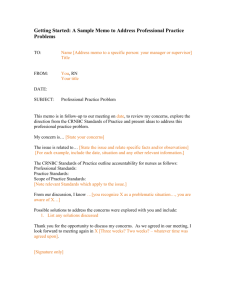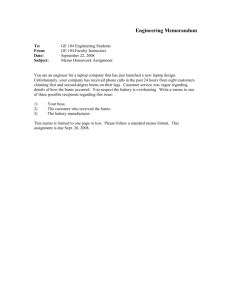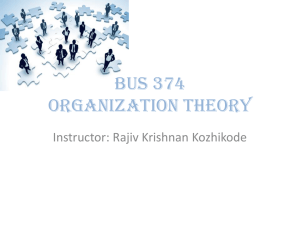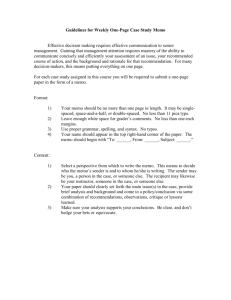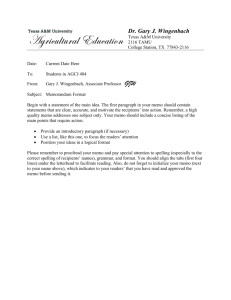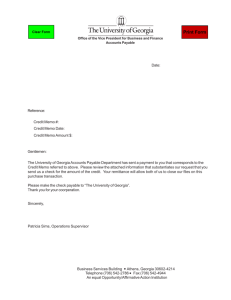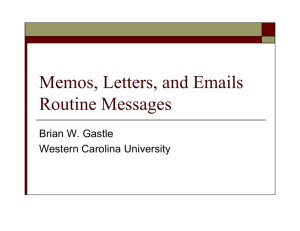Leadership Empowerment & Coaching
advertisement
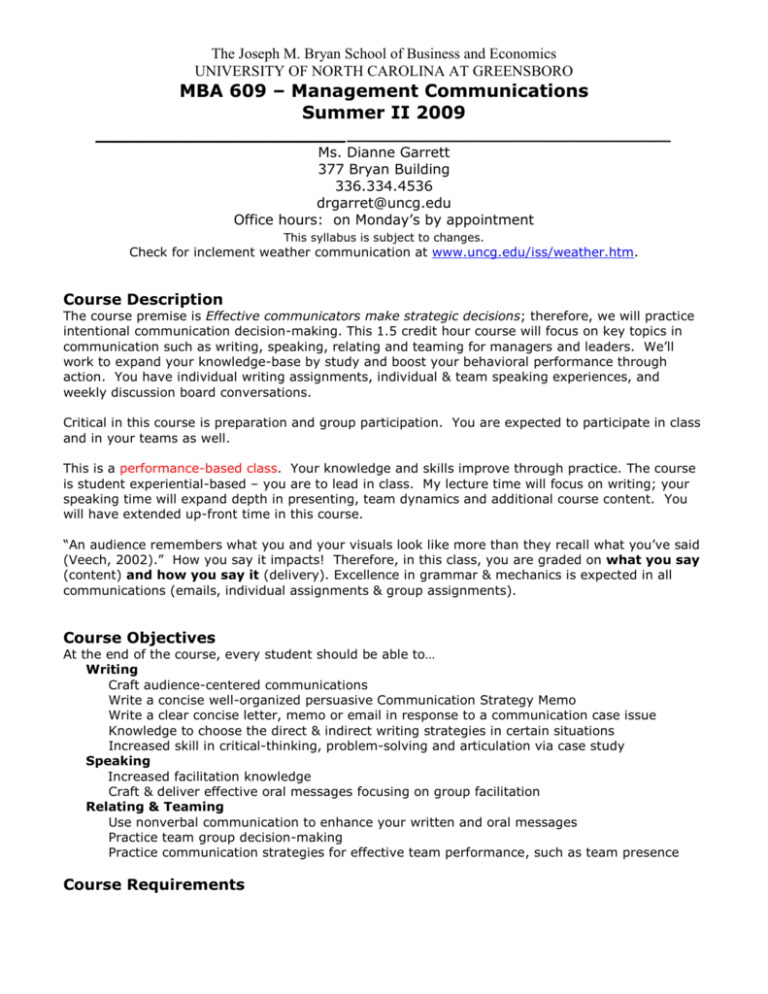
The Joseph M. Bryan School of Business and Economics UNIVERSITY OF NORTH CAROLINA AT GREENSBORO MBA 609 – Management Communications Summer II 2009 _____________________________________________________ Ms. Dianne Garrett 377 Bryan Building 336.334.4536 drgarret@uncg.edu Office hours: on Monday’s by appointment This syllabus is subject to changes. Check for inclement weather communication at www.uncg.edu/iss/weather.htm. Course Description The course premise is Effective communicators make strategic decisions; therefore, we will practice intentional communication decision-making. This 1.5 credit hour course will focus on key topics in communication such as writing, speaking, relating and teaming for managers and leaders. We’ll work to expand your knowledge-base by study and boost your behavioral performance through action. You have individual writing assignments, individual & team speaking experiences, and weekly discussion board conversations. Critical in this course is preparation and group participation. You are expected to participate in class and in your teams as well. This is a performance-based class. Your knowledge and skills improve through practice. The course is student experiential-based – you are to lead in class. My lecture time will focus on writing; your speaking time will expand depth in presenting, team dynamics and additional course content. You will have extended up-front time in this course. “An audience remembers what you and your visuals look like more than they recall what you’ve said (Veech, 2002).” How you say it impacts! Therefore, in this class, you are graded on what you say (content) and how you say it (delivery). Excellence in grammar & mechanics is expected in all communications (emails, individual assignments & group assignments). Course Objectives At the end of the course, every student should be able to… Writing Craft audience-centered communications Write a concise well-organized persuasive Communication Strategy Memo Write a clear concise letter, memo or email in response to a communication case issue Knowledge to choose the direct & indirect writing strategies in certain situations Increased skill in critical-thinking, problem-solving and articulation via case study Speaking Increased facilitation knowledge Craft & deliver effective oral messages focusing on group facilitation Relating & Teaming Use nonverbal communication to enhance your written and oral messages Practice team group decision-making Practice communication strategies for effective team performance, such as team presence Course Requirements The Joseph M. Bryan School of Business and Economics UNIVERSITY OF NORTH CAROLINA AT GREENSBORO Required text: Managerial Communication Strategies, An Applied Casebook by Annette Veech. ISBN – 0-13-060821-1 Course Text: download the ebook from the UNCG library at http://www.bartleby.com/141/. This text by Stunk & White, although written quite some time ago, is wonderful at teaching paragraphing. Please review this book for information to advance your writing. Highly Recommended: Writing That Works, Communicating Effectively on the Job, 9 th Edition by Walter Oliu, Charles Brusaw, Gerald Alred. ISBN – 10:0-312-44844-9 ISBN-13:978-0-31244844-8 Attend every class. Contact the instructor immediately for extenuating circumstances. Remember, your teammates need you. Class will be affected by your absence. By registering for this course, you are agreeing to abide by the UNCG honor code. Read the code on the website at http://academicintegrity.uncg.edu/. Any violation will be pursued. Read the Faculty/Student Guidelines: http://www.uncg.edu/bae/faculty_student_guidelines_sp07.pdf. Blackboard proficiency Classroom Behaviors Do not turn in late work; I might not take it. And if I do take it, your grade will be lowered a full letter grade. No make-up presentations are given. When you email me, use what you are being taught. I expect a well-crafted email. If you write poorly, I may respond with an email asking you to recompose your message. Like your boss, I expect you to follow instructions. Business success is balancing the following of instructions to creativity and innovation. You will receive feedback on your writing and speaking. View this feedback as a gift to grow in your skills instead of personal criticism. You will learn more if you do not let any feelings of resistance keep you from listening and applying the information. My Values I also value integrity. Integrity is the cornerstone to a life of good character and ethical business behavior; therefore, it is foundational in my classroom. Be honest and respectful. Live honor. I am a performance coach. I am optimistic and will hold you to excellence in performance. I believe in accountability. The coaching conversation is a frequent tool I use. Course Assessments & Activities Grading Standards: A Business Writing Checklist document and a Speaking Checklist document are feedback & grading tools. These documents are posted in Blackboard. A, A-, B+, B, B-, C+, C, F A = 100-94; A- = 93-90; B+ = 89–87; B = 86–84; B- = 83–80; C+ = 79–77; C = 76–74; F = 73 & below Graded Activities: 1. Reflection DB 2. Weekly Writing Assignments: Strategy & Execution documents 3. Speaking: Team Case Facilitation, Team HBR Facilitation 15% 50% 20% The Joseph M. Bryan School of Business and Economics UNIVERSITY OF NORTH CAROLINA AT GREENSBORO 4. Final: Concept Application/Letter of Transmittal 15% 1. Reflection Discussion Board (15%) Within 48 hours after class, you are to post your class learnings to the Reflections Discussion Board. These are graded postings, so write a well-crafted organized message. Engage in conversation with the class. “I agree.’ is a not an acceptable post. You are to have at least 3 quality posts/discussion board for a ‘C+’ grade: one personal reflection and two responses/challenges/questions to classmates. The purpose of this work is to drive in your learning and experience the impact of you and your learnings on your classmates. We learn from one another. 2. Case Writing Assignments (50%) Submit your works according to the stated procedures. If you submit your work outside of protocol, it is likely you will not receive it back with the rest of class. Be sure to write your name and section number on the paper – in the right upper corner please. You are to hand-in your submissions in hard copy at the beginning of class. And secondly, you are to post your work to your private Blog - one that only you and I share. This Blog will be used as back up and perhaps grading electronically. Do not email me your assignments unless we have had conversation and agreed to this medium. Strategy Memo & Execution Document You have two documents to produce for the case writing assignments: a strategy memo & an execution memo. You are to submit the strategic memo before the class discussion and the execution memo at the next class period. A well-crafted and delivered strategy is the important factor. It’s not important that I agree or disagree with your chosen strategy or recommendations, what is important is your ability to communicate (deliver) the information. 1. The Strategy Memo: Use the defined format as defined on the last page of this document. Organization & depth of analysis are key factors. The message is to be in great flow. Link the relationships of the problems to the stakeholders to the strategy to the solutions & actions. 2. Execution Document: After our class discussion, you are to create a written work of application - could be a letter, a memo, a speech, etc. that demonstrates your strategic intention of the case communication issue. Your execution decision can be different than your initial strategy decision as after class discussion you will have increased your knowledge and perhaps choose a new implementation decision. Be sure to weave in course topic information (the HBR articles, Veech text, your research) into your writing assignments. All hard-copy submissions are to have a completed Business Writing Checklist coversheet. Write comments to me as warranted. The Joseph M. Bryan School of Business and Economics UNIVERSITY OF NORTH CAROLINA AT GREENSBORO 3. I give feedback. Learn to welcome the information. Take the feedback as a gift and improve. Grades ‘A’ & ‘F’ get less feedback – you know the intention and you achieved it or you need to see me. Grades ‘B’ & ‘C’ get the most feedback. I do not bring attention to every single ‘error.’ You are to inspect your paper for recurrences of the same mention. See me quickly if you have a question – with just a few weeks of class, we don’t have time for inactivity. You will be assigned to a team. You are encouraged to discuss strategy and be each other’s editor. Collaboration is business behavior. However, I caution you – each individual write is to be an individual write. The top writing assignments will be chosen from class and posted as models. This sharing of information gives you an opportunity to learn from one another. Once papers are returned, you are responsible to monitor your Blackboard grades. See me within a week for any points of discussion. Speaking Activities (20%) Impromptu Speaking Activity. You will speak in front of the class. Team Case Facilitation. You are assigned a team for case strategy discussion. You are encouraged to lead your facilitation in differing ways. Team HBR article Facilitation. In your facilitation teams, you will lead class discussion on the weekly assigned HBR article. You are allowed creative freedom in the way you lead class. 4. Final Concept Application Paper (15%) You are to write a 2+ page single-spaced memo (to me) on a concept in the course: conflict management, team or meeting communication, business writing, nonverbal communication, speaking, etc. This is to be an in-depth application using course information – how will you apply this information to your business life? Use business writing techniques on the academic writing assignment. You are to be 50% content, 50% application. You are to have at least 4 cites that detail additional information. Be sure to cite the HBR articles used in class. Letter of Transmittal (5%) Report (2+ pages and a Works Cited page) (10%) The Joseph M. Bryan School of Business and Economics UNIVERSITY OF NORTH CAROLINA AT GREENSBORO Memorandum To: cc: From: Date: Subject: Communication Strategy & Actions for _______________ The purpose of this memo is to inform you on my recommended communication strategy supported by situation and analysis information. Background or What’s Going On? What’s Success? State your purpose? Explain the circumstances that lead up to the problem. (This is the smallest of the 4 sections.) This section is case situation information. State your assumptions & premises. State the communication question or problem you are solving – maybe in a question. Analysis or What’s the Question? What are the possible answers? Strategy Exploration Discuss possible solutions to the communication dilemma. Do not choose your solution now. It is likely there is an abundance of possibilities for directional communication decision. You must be clear on what you are solving. Jumping too quickly into solution could cause major leadership problems. Offer three possible solutions. Here are some important mentions in exploration of the communications problem. You are invited to present this information in a table. Who are the players in this need? Are the favorable or not to the message. This affects your approach decision (direct or indirect). o Stakeholders (internal & external – identify the players: primary, secondary & tertiary) o Who is the audience? What is their attitude towards the message – favorable or not? o Audience’s relationship to the communicator. What is the impact of the problem on each audience group? What message needs to be communicated to each group? Is it the same message? What is the best delivery method? (letter, memo, email, presentation, conference call, web seminar, voicemail, speech, meeting, series of meetings, etc.) What is the best time to deliver the message? Use a direct or indirect approach? Are there any important relationships to mention? What are the emotions involved of the differing audiences? Decision, Recommendation or Solution with Action Definition In a concise sentence or small paragraph, detail the decision/solution approach – your communication strategy approach. The Joseph M. Bryan School of Business and Economics UNIVERSITY OF NORTH CAROLINA AT GREENSBORO Detail your recommendations/action items. Be sure to offer a solution to each primary problem & address the stakeholder issues. Don’t leave loose ends. For example – Background – I need to layoff 50 staff people. How do I tell them? Analysis – Who needs this information? How will it impact each group? Memo? Inperson? Individual Meetings? Group Meetings? Do I tell the managers first? Decision & Actions – I will tell the managers by face-to-face meetings. I will do a companywide presentation followed up with a company-wide memo. *Heading questions from Hurson, Tim. (2008). Think Better. McGraw-Hill, New York, NY.


